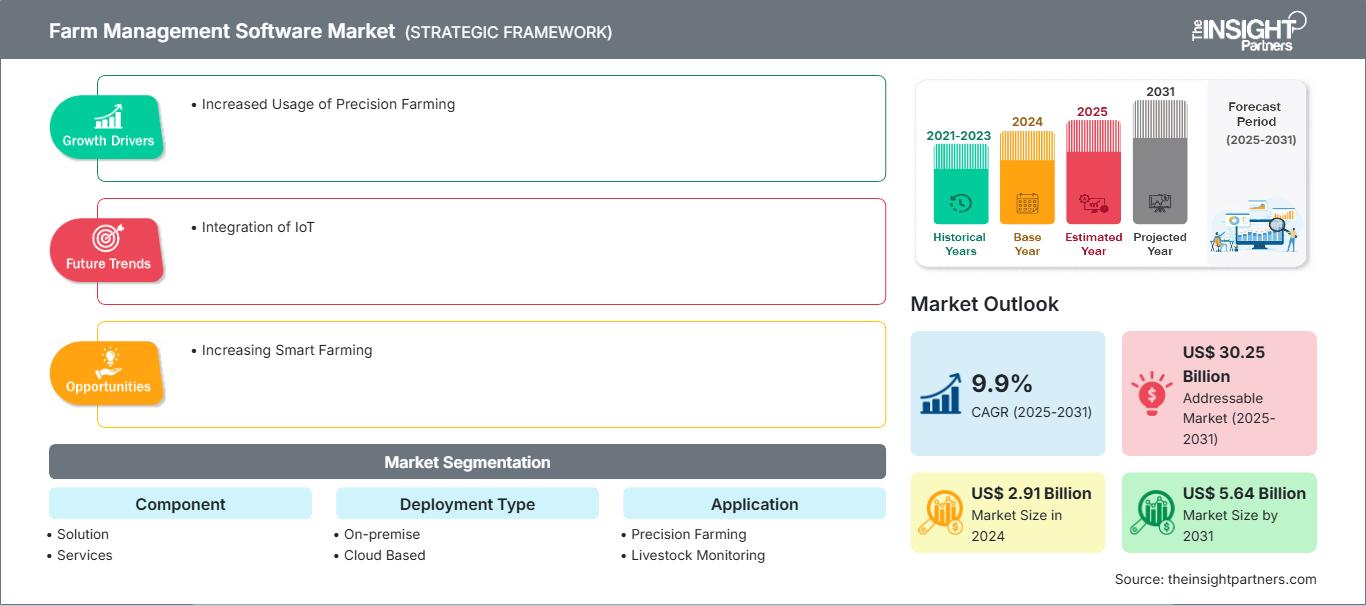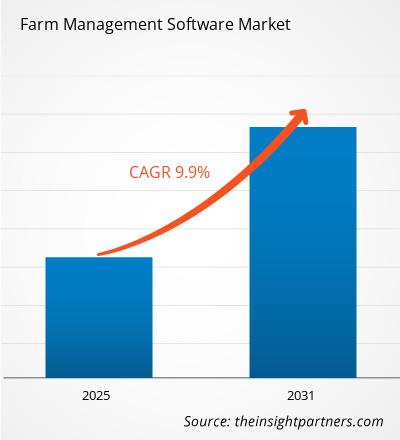농장 관리 소프트웨어 시장 규모는 2023년 26억 5천만 달러에서 2031년에는 56억 4천만 달러에 이를 것으로 예상됩니다. 2023년부터 2031년까지 연평균 성장률 9.9%를 기록할 것으로 예상됩니다. 소프트웨어와 사물인터넷(IoT)의 통합은 시장의 주요 트렌드로 남을 것으로 보입니다.
농장 관리 소프트웨어 시장 분석
디지털 시대에 기술은 혁신의 원동력으로 부상하며, 농장 관리 소프트웨어(FMS)는 현대 농업의 과제를 해결하는 강력한 도구로 자리매김하고 있습니다. 지속 가능한 농업으로 나아가려면 단순히 씨앗을 뿌리는 것 이상의 노력이 필요합니다. 스마트하고 효율적인 농장 관리가 필수적입니다. 자원 활용 최적화부터 생산성 향상 및 환경 관리까지, FMS는 필수적인 요소입니다. 농업 운영에 농장 관리 소프트웨어를 도입하면 비용이 절감되고, 수확량이 증가하며, 제품 품질이 향상되고, 수익이 증가하며, 운영 위험이 감소합니다.
농장 관리 소프트웨어 시장 개요
농장 관리 소프트웨어는 효율성, 자원 활용도, 그리고 의사 결정을 향상시켜 지속 가능한 농업을 발전시키는 데 필수적입니다. 농장 관리 소프트웨어는 농부들이 작물 수확량을 최적화하고, 환경 영향을 모니터링하며, 장기적인 농업 지속가능성을 위한 책임 있는 관행을 장려하도록 지원합니다. 농장 관리는 농부들에게 귀중한 도구로서, 운영 방식을 간소화하고, 자원 관리를 개선하며, 지속 가능한 농업 관행을 구현할 수 있도록 지원합니다. 데이터 기반 통찰력을 제공함으로써 농부들은 정보에 기반한 의사 결정을 내리고, 환경적 지속가능성, 경제적 타당성, 그리고 농업의 장기적인 지속가능성을 증진할 수 있습니다. 데이터 분석을 농장 관리에 통합하면 의사 결정이 더욱 개선됩니다. 농부들은 기상 패턴, 토양 건강, 작물 성과에 대한 과거 및 실시간 데이터를 분석하여 정보에 기반한 의사 결정을 내릴 수 있습니다. 이를 통해 농부들은 신속하게 전략을 조정하고, 문제에 효과적으로 대응하며, 궁극적으로 생산성을 극대화할 수 있습니다.
요구 사항에 맞게 이 보고서를 사용자 정의하십시오.
이 보고서의 일부, 국가 수준 분석, Excel 데이터 팩을 포함하여 모든 보고서에 대한 사용자 정의를 무료로 받을 수 있을 뿐만 아니라 스타트업 및 대학을 위한 훌륭한 제안 및 할인을 이용할 수 있습니다
농장 관리 소프트웨어 시장: 전략적 통찰력

- 이 보고서의 주요 주요 시장 동향을 확인하세요.이 무료 샘플에는 시장 동향부터 추정 및 예측에 이르기까지 데이터 분석이 포함됩니다.
이 보고서의 일부, 국가 수준 분석, Excel 데이터 팩을 포함하여 모든 보고서에 대한 사용자 정의를 무료로 받을 수 있을 뿐만 아니라 스타트업 및 대학을 위한 훌륭한 제안 및 할인을 이용할 수 있습니다
농장 관리 소프트웨어 시장: 전략적 통찰력

- 이 보고서의 주요 주요 시장 동향을 확인하세요.이 무료 샘플에는 시장 동향부터 추정 및 예측에 이르기까지 데이터 분석이 포함됩니다.
농장 관리 소프트웨어 시장 성장 동력 및 기회
정밀 농업 활용 확대로 시장 활성화
다음 기술을 활용함으로써 농부들은 증가하는 식량 수요를 충족하는 동시에 환경 영향을 최소화하고 천연자원을 보존할 수 있습니다. 이로 인해 전 세계 농부들이 정밀 농업을 활용하고 있습니다. 예를 들어, DEFRA(농업부) 설문 조사에 따르면 영국 농부들은 생산성 또는 성과 향상(78%), 정확도 향상(59%), 그리고 투입 비용 절감(55%)을 위해 정밀 농업을 활용하고 있습니다. 정밀 농업은 GPS, 원격 감지, 데이터 분석과 같은 첨단 기술을 활용하여 농업 관행을 개선합니다. 토양 상태, 작물 건강, 기상 패턴에 대한 데이터를 수집하고 분석함으로써 농부들은 관개, 시비, 해충 방제와 관련하여 정확한 결정을 내릴 수 있습니다. 이러한 집중적인 접근 방식은 자원 낭비를 최소화하고 환경 영향을 줄이며 전반적인 생산성을 향상시킵니다. 농장 관리 소프트웨어는 GIS와 위성 이미지를 활용하여 농장의 상세 지도를 생성합니다. 이러한 도구를 통해 농부는 토양 변화를 평가하고, 파종을 최적화하고, 비료 및 살충제와 같은 투입재를 필요한 곳에 정확하게 적용할 수 있습니다. 따라서 정밀 농업 사용 증가는 농장 관리 소프트웨어 시장의 성장을 촉진합니다.
스마트 농업의 확대
스마트 농업은 첨단 센서와 카메라가 통합된 장비를 사용합니다. 스마트 농업은 클라우드, 빅데이터, 사물 인터넷(IoT)과 같은 첨단 기술을 활용하여 농업 활동을 추적, 자동화, 모니터링 및 분석하는 데 필요한 인프라를 농업 사업체에 제공하는 것을 목표로 하는 관리 개념입니다. 스마트 농업은 소프트웨어로 제어되고 센서로 모니터링됩니다. 또한, 다양한 기관에서 스마트 농업을 활용하여 생산량을 늘리고 있습니다. 예를 들어, 2021년 2월, AKVA 그룹은 노르웨이 전역의 여러 지역에 AKVAconnect 4 카메라 시스템 제어 기능을 갖춘 SmartEye Precision HD 카메라 45대를 설치하는 5년 계약을 Trollvika Drift AS와 체결했습니다. 따라서 스마트 농업의 증가는 IoT, AI 등과 같은 새로운 기술의 사용을 요구하고 있습니다. 따라서 스마트 농업의 확대는 농장 관리 소프트웨어 시장에 기회를 창출합니다.
농장 관리 소프트웨어 시장 보고서 세분화 분석
농장 관리 소프트웨어 시장 분석에 기여한 주요 세그먼트는 구성 요소, 배포 유형, 그리고 애플리케이션입니다.
- 구성 요소를 기준으로 농장 관리 소프트웨어 시장은 솔루션 서비스로 구분됩니다.
- 배포 유형을 기준으로 시장은 온프레미스, 클라우드 기반으로 구분됩니다. 클라우드 기반 세그먼트는 향후 몇 년 동안 농장 관리 소프트웨어 시장 점유율이 가장 높을 것으로 예상됩니다. 시장에서 클라우드 기반 솔루션은 사용자가 서버 인프라에 투자할 필요성을 없애 서버 관리, 하드웨어 조달, 소프트웨어 라이선스, 데이터 백업 및 보안 조치와 관련된 비용을 크게 절감합니다.
- 적용 분야별로 시장은 정밀 농업, 가축 모니터링, 기타로 세분화됩니다.
지역별 농장 관리 소프트웨어 시장 점유율 분석
농장 관리 소프트웨어 시장 보고서의 지리적 범위는 주로 북미, 아시아 태평양, 유럽, 중동 및 아프리카, 중남미의 5개 지역으로 나뉩니다. 북미는 정밀 농업 관행 도입, 효율적인 자원 관리, 그리고 지속가능성에 대한 집중을 강화하고 있으며, 이러한 모든 요소가 고급 농장 관리 소프트웨어 솔루션에 대한 수요를 견인하고 있습니다. 또한, 데이터 기반 의사 결정과 지속적인 기술 발전에 대한 중요성이 커짐에 따라 북미의 시장 점유율은 크게 증가하고 있습니다. 이러한 요소들은 농부들이 끊임없이 변화하는 농업 분야에서 운영을 최적화하고 생산성을 향상시키며 경쟁 우위를 유지할 수 있도록 지원합니다. 시장을 주도하는 또 다른 중요한 요인은 농업 분야에서 데이터 기반 의사 결정에 대한 중요성이 커지고 있다는 것입니다.
농장 관리 소프트웨어 시장 지역별 통찰력
The Insight Partners의 분석가들은 예측 기간 동안 농장 관리 소프트웨어 시장에 영향을 미치는 지역별 동향과 요인들을 면밀히 분석했습니다. 이 섹션에서는 북미, 유럽, 아시아 태평양, 중동 및 아프리카, 그리고 중남미 지역의 농장 관리 소프트웨어 시장 부문 및 지역별 현황도 살펴봅니다.
농장 관리 소프트웨어 시장 보고서 범위
| 보고서 속성 | 세부 |
|---|---|
| 시장 규모 2024 | US$ 2.91 Billion |
| 시장규모별 2031 | US$ 5.64 Billion |
| 글로벌 CAGR (2025 - 2031) | 9.9% |
| 이전 데이터 | 2021-2023 |
| 예측 기간 | 2025-2031 |
| 다루는 세그먼트 |
By 구성 요소
|
| 포함된 지역 및 국가 | 북미
|
| 시장 선도 기업 및 주요 회사 프로필 |
|
농장 관리 소프트웨어 시장 참여자 밀도: 비즈니스 역학에 미치는 영향 이해
농장 관리 소프트웨어 시장은 소비자 선호도 변화, 기술 발전, 그리고 제품의 이점에 대한 인식 제고 등의 요인으로 인한 최종 사용자 수요 증가에 힘입어 빠르게 성장하고 있습니다. 수요가 증가함에 따라 기업들은 제품 및 서비스를 확장하고, 소비자 니즈를 충족하기 위한 혁신을 추진하며, 새로운 트렌드를 적극 활용하고 있으며, 이는 시장 성장을 더욱 가속화하고 있습니다.

- 을 얻으세요 농장 관리 소프트웨어 시장 주요 주요 플레이어 개요
농장 관리 소프트웨어 시장 뉴스 및 최근 동향
농장 관리 소프트웨어 시장은 1차 및 2차 조사 이후 주요 기업 간행물, 협회 데이터, 데이터베이스 등 정성적 및 정량적 데이터를 수집하여 평가합니다. 농장 관리 소프트웨어 시장의 몇 가지 동향은 다음과 같습니다.
- John Deere & Company는 SpaceX와 전략적 파트너십을 맺고 농부들에게 위성 통신(SATCOM) 서비스를 제공할 예정입니다. 이 혁신적인 솔루션은 농촌 지역 농부들이 직면한 연결 문제를 해결하고 정밀 농업 관행을 개선하며 생산성, 수익성, 지속가능성을 향상시키는 것을 목표로 합니다. SpaceX가 개발한 첨단 Starlink 네트워크를 활용하여 SATCOM 서비스는 농업 운영에 사용되는 신규 및 기존 장비를 모두 연결합니다. (출처: John Deere & Company, 2024년 1월)
- 솔루션 기반 농장 관리 소프트웨어(FMS) 분야의 세계적인 선도 기업인 Conservis와 디지털 가축 사업 관리 소프트웨어 분야의 세계적인 선두 기업인 AgriWebb은 전략적 공동 마케팅 파트너십을 발표했습니다. 이번 협력은 작물 및 가축 생산에 참여하는 농부들에게 포괄적이고 진보된 기술을 제공하는 것을 목표로 합니다. (출처: Conservis, 2022년 2월)
농장 관리 소프트웨어 시장 보고서 범위 및 결과
“농장 관리 소프트웨어 시장 규모 및 예측(2021~2031)” 보고서는 다음 영역을 포괄하는 시장에 대한 자세한 분석을 제공합니다.
- 범위에 포함된 모든 주요 시장 부문에 대한 글로벌, 지역 및 국가 수준의 농장 관리 소프트웨어 시장 규모 및 예측
- 농장 관리 소프트웨어 시장 동향 및 추진 요인, 제약 및 주요 기회와 같은 시장 역학
- 자세한 PEST/포터의 5가지 힘 및 SWOT 분석
- 주요 시장 동향, 글로벌 및 지역 프레임워크, 주요 업체, 규정 및 최근 시장 개발 사항을 포괄하는 농장 관리 소프트웨어 시장 분석
- 시장 집중도, 히트맵 분석, 주요 업체 및 농장 관리 소프트웨어 시장의 최근 개발 사항을 포괄하는 산업 환경 및 경쟁 분석
- 자세한 회사 프로필
- 과거 분석(2년), 기준 연도, CAGR을 포함한 예측(7년)
- PEST 및 SWOT 분석
- 시장 규모 가치/거래량 - 글로벌, 지역, 국가
- 산업 및 경쟁 환경
- Excel 데이터세트
최근 보고서
관련 보고서
사용 후기
구매 이유
- 정보에 기반한 의사 결정
- 시장 역학 이해
- 경쟁 분석
- 고객 인사이트
- 시장 예측
- 위험 완화
- 전략 기획
- 투자 타당성 분석
- 신흥 시장 파악
- 마케팅 전략 강화
- 운영 효율성 향상
- 규제 동향에 발맞춰 대응




















 무료 샘플 받기 - 농장 관리 소프트웨어 시장
무료 샘플 받기 - 농장 관리 소프트웨어 시장